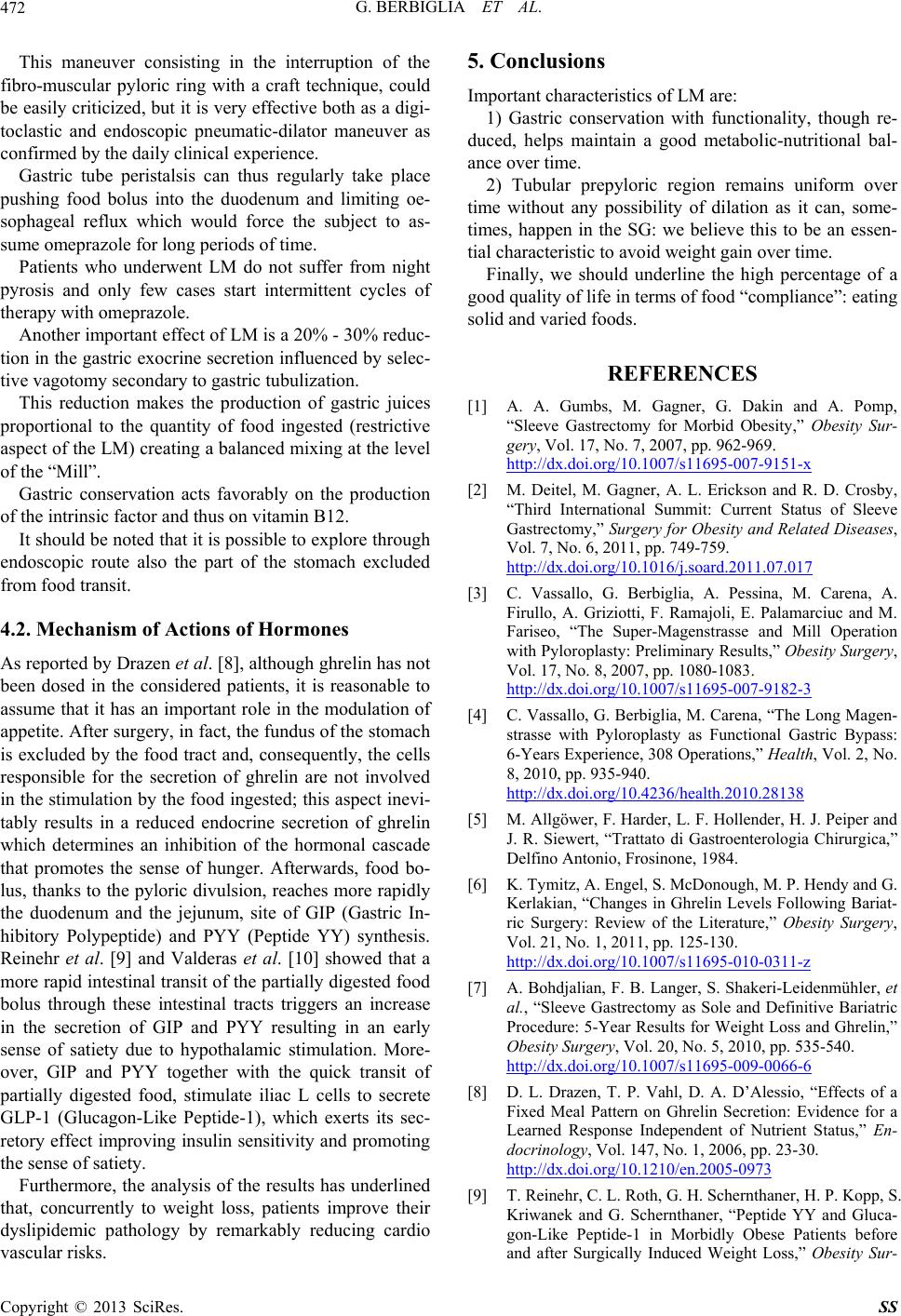
G. BERBIGLIA ET AL.
472
This maneuver consisting in the interruption of the
fib
y take place
pu
er from night
py
LM is a 20% - 30% reduc-
tio
c juices
pr
ervation acts favorably on the production
of
e through
en
4.2. Mechanism of Actions of Hormones
in has not
alysis of the results has underlined
th
ns
istics of LM are:
nality, though re-
du
yloric region remains uniform over
tim
e of a
go
REFERENCES
[1] A. A. Gumbin and A. Pomp,
-x
ro-muscular pyloric ring with a craft technique, could
be easily criticized, but it is very effective both as a digi-
toclastic and endoscopic pneumatic-dilator maneuver as
confirmed by the daily clinical experience.
Gastric tube peristalsis can thus regularl
shing food bolus into the duodenum and limiting oe-
sophageal reflux which would force the subject to as-
sume omeprazole for long periods of time.
Patients who underwent LM do not suff
rosis and only few cases start intermittent cycles of
therapy with omeprazole.
Another important effect of
n in the gastric exocrine secretion influenced by selec-
tive vagotomy secondary to gastric tubulization.
This reduction makes the production of gastri
oportional to the quantity of food ingested (restrictive
aspect of the LM) creating a balanced mixing at the level
of the “Mill”.
Gastric cons
“Sle
the intrinsic factor and thus on vitamin B12.
It should be noted that it is possible to explor
doscopic route also the part of the stomach excluded
from food transit.
As reported by Drazen et al. [8], although ghrel
been dosed in the considered patients, it is reasonable to
assume that it has an important role in the modulation of
appetite. After surgery, in fact, the fundus of the stomach
is excluded by the food tract and, consequently, the cells
responsible for the secretion of ghrelin are not involved
in the stimulation by the food ingested; this aspect inevi-
tably results in a reduced endocrine secretion of ghrelin
which determines an inhibition of the hormonal cascade
that promotes the sense of hunger. Afterwards, food bo-
lus, thanks to the pyloric divulsion, reaches more rapidly
the duodenum and the jejunum, site of GIP (Gastric In-
hibitory Polypeptide) and PYY (Peptide YY) synthesis.
Reinehr et al. [9] and Valderas et al. [10] showed that a
more rapid intestinal transit of the partially digested food
bolus through these intestinal tracts triggers an increase
in the secretion of GIP and PYY resulting in an early
sense of satiety due to hypothalamic stimulation. More-
over, GIP and PYY together with the quick transit of
partially digested food, stimulate iliac L cells to secrete
GLP-1 (Glucagon-Like Peptide-1), which exerts its sec-
retory effect improving insulin sensitivity and promoting
the sense of satiety.
Furthermore, the an
at, concurrently to weight loss, patients improve their
dyslipidemic pathology by remarkably reducing cardio
vascular risks.
5. Conclusio
Important character
1) Gastric conservation with functio
ced, helps maintain a good metabolic-nutritional bal-
ance over time.
2) Tubular prep
e without any possibility of dilation as it can, some-
times, happen in the SG: we believe this to be an essen-
tial characteristic to avoid weight gain over time.
Finally, we should underline the high percentag
od quality of life in terms of food “compliance”: eating
solid and varied foods.
s, M. Gagner, G. Dak
eve Gastrectomy for Morbid Obesity,” Obesity Sur-
gery, Vol. 17, No. 7, 2007, pp. 962-969.
http://dx.doi.org/10.1007/s11695-007-9151
y,
11.07.017
[2] M. Deitel, M. Gagner, A. L. Erickson and R. D. Crosb
“Third International Summit: Current Status of Sleeve
Gastrectomy,” Surgery for Obesity and Related Diseases,
Vol. 7, No. 6, 2011, pp. 749-759.
http://dx.doi.org/10.1016/j.soard.20
Carena, A.
182-3
[3] C. Vassallo, G. Berbiglia, A. Pessina, M.
Firullo, A. Griziotti, F. Ramajoli, E. Palamarciuc and M.
Fariseo, “The Super-Magenstrasse and Mill Operation
with Pyloroplasty: Preliminary Results,” Obesity Surgery,
Vol. 17, No. 8, 2007, pp. 1080-1083.
http://dx.doi.org/10.1007/s11695-007-9
ng Magen-[4] C. Vassallo, G. Berbiglia, M. Carena, “The Lo
strasse with Pyloroplasty as Functional Gastric Bypass:
6-Years Experience, 308 Operations,” Health, Vol. 2, No.
8, 2010, pp. 935-940.
http://dx.doi.org/10.4236/health.2010.28138
[5] M. Allgöwer, F. Harder, L. F. Hollender, H. J. Peiper and
h, M. P. Hendy and G.
-0311-z
J. R. Siewert, “Trattato di Gastroenterologia Chirurgica,”
Delfino Antonio, Frosinone, 1984.
[6] K. Tymitz, A. Engel, S. McDonoug
Kerlakian, “Changes in Ghrelin Levels Following Bariat-
ric Surgery: Review of the Literature,” Obesity Surgery,
Vol. 21, No. 1, 2011, pp. 125-130.
http://dx.doi.org/10.1007/s11695-010
nmühler, et [7] A. Bohdjalian, F. B. Langer, S. Shakeri-Leide
al., “Sleeve Gastrectomy as Sole and Definitive Bariatric
Procedure: 5-Year Results for Weight Loss and Ghrelin,”
Obesity Surgery, Vol. 20, No. 5, 2010, pp. 535-540.
http://dx.doi.org/10.1007/s11695-009-0066-6
[8] D. L. Drazen, T. P. Vahl, D. A. D’Alessio, “Effects of a
Fixed Meal Pattern on Ghrelin Secretion: Evidence for a
Learned Response Independent of Nutrient Status,” En-
docrinology, Vol. 147, No. 1, 2006, pp. 23-30.
http://dx.doi.org/10.1210/en.2005-0973
[9] T. Reinehr, C. L. Roth, G. H. Schernthaner, H. P. Kopp, S.
and after Surgically Induced Weight Loss,” Obesity Sur-
Kriwanek and G. Schernthaner, “Peptide YY and Gluca-
gon-Like Peptide-1 in Morbidly Obese Patients before
Copyright © 2013 SciRes. SS